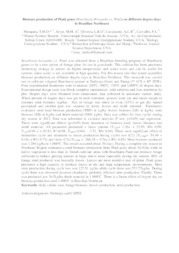Biomass production of Piatã grass (Brachiaria Brizantha cv. Piatã) on different degree days in Brazilian Northeast.
Biomass production of Piatã grass (Brachiaria Brizantha cv. Piatã) on different degree days in Brazilian Northeast.
Author(s): MESQUITA, T. M. O.; ALVES, M. M. A.; OLIVEIRA, L. B. O.; CAVALCANTE, A. C. R.; CARVALHO, F. C.
Summary: Brachiaria brizantha cv. Piatã was released from a Brazilian breeding program of Brachiaria genus to be a new option of forage plant for use in grasslands. This cultivar has been presented interesting strategy to persist on higher temperatures and water stress and can be useful for systems when water is not available in high quantity. For this reason this trial aimed quantifies biomass production on different degree days in Brazilian Northeast. This research was carried out in cultivate irrigated Brachiaria pasture at Embrapa Goats and Sheep (3º 41'S e 40º 20'W). Four experimental treatments were evaluated: 250ºC, 500ºC, 750ºC and 1,000ºC of degree days. Experimental design used was block complete randomized, with subplots and four repetition by plot. Degree days were obtained from temperature data collected in automatic station, daily. When amount of degree days was get in each treatment, grasses were cut and taken weight to estimate total biomass (kg/ha). Part of forage was dried in oven (55ºC) to get dry matter perceptual and another part was separate in stems, leaves and death material. Parameters evaluated were total biomass production (TBP) in kg/ha, leaves biomass (LB) in kg/ha, stem biomass (SB) in kg/ha and death material (DM) kg/ha. Data was collect for four cycles during dry season in 2012. Data was submitted to variance analysis (F test, p<0.05) and regression. There were significant effects (p<0.05) from treatment to biomass total, leaves biomass and death material. All parameter presented a linear pattern (YTBP= 1.26x + 23.95; R²= 0.99; YLB=0.94 x + 82.91; R2 =0.98; YDM= 0.04x ? 3.51; R²= 0.84). There were significant effect of interaction cycle and treatment to steam production during cycles two (C2) (YC2SB= -54.49 + 0.18x e R²= 0.73) and three (C3) (YC3SB = -206.28 + 0.76x e R²= 0.85). Most biomass produced was 1,284 kg/ha in 1,000ºC. This result occurred about 30 days. During a complete dry season in Northeast Region estimated a total biomass production from Piatã grass about 10.3t/ha while in native vegetation is less than 2t. Small cultivate areas with Brachiaria Piatã can produce forage sufficient to reduce grazing pasture in large native areas especially during dry season. 80% of forage total produced was basically leaves. Leaves are most nutritive part of plant. Piatã grass presented a high capacity to produce leaves in dry and high temperature environments. Most stem production during cycle two was 125.51 kg/ha while cycle three was 553.72kg/ha. During cycle three was observed increase cloudiness, probably affected stem production. Finally, There was produced just 36,5kg/ha death material in 1,000ºC. There is a linear effect of degree day on biomass production until 1,000ºC in Brazilian Northeast.
Publication year: 2013
Types of publication: Abstract in annals or event proceedings
Unit: Embrapa Goats & Sheep
Observation
Some of Embrapa's publications are published as ePub files. To read them, use or download one of the following free software options to your computer or mobile device. Android: Google Play Books; IOS: iBooks; Windows and Linux: Calibre.
Access other publications
Access the Agricultural Research Database (BDPA) to consult Embrapa's full library collection and records.
Visit Embrapa Bookstore to purchase books and other publications sold by Embrapa.

